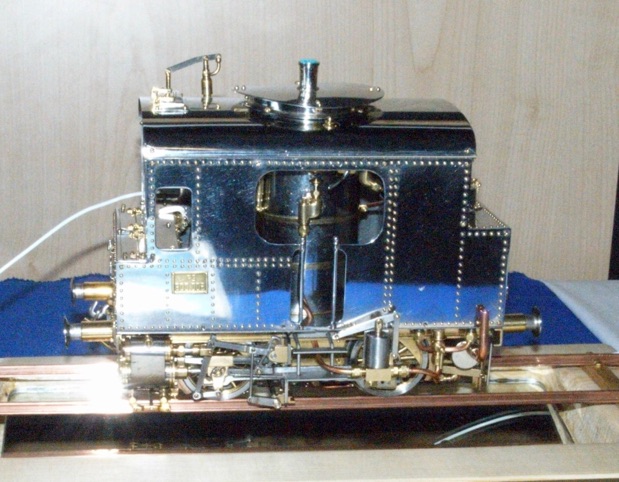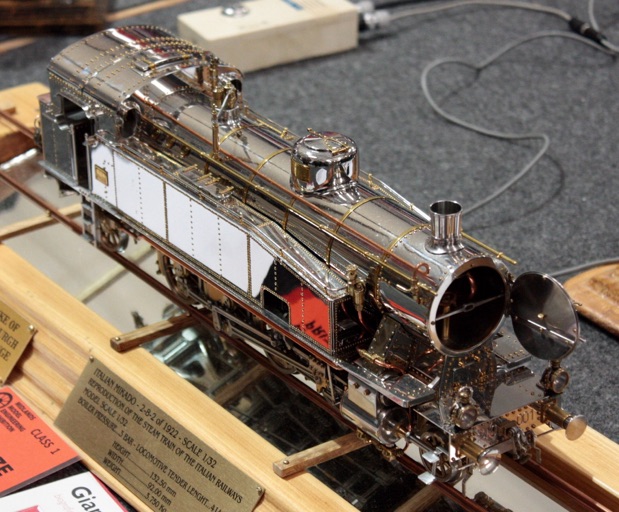
But we are lucky to see them.
Back in 2005 Giancarlo was seriously injured in a rail disaster near Bologna. From his hospital bed he delivered a rant, saying that he would like to see the transport minister and his sidekicks to show the result from a list of safety measures no longer in place.
“Here they are!” exclaimed Giancarlo with leg fractures and chest injuries.
Later, the man who joined the railway in 1972, was visited by minister Lunardi, and delivered a lecture on measures that needed to be taken to return to acceptable safety levels which had fallen in a drive from bureaucracy to ‘efficiency’.
Giancarlo had been returning from an exhibition to his home in Nocera, Umbra. To add insult to his injuries worse, he lost a 750 Gauge 1 locomotive in the disaster.
All of the models are of the highest craftsmanship. Unusually, they are not painted which allows us better to see the quality of the work. And as the main construction material is polished stainless steel, the degree of difficulty is that little bit higher than usual. And that adds a ‘wow’ factor, too. The only paint to be found is on the wooden lagging of the oldest prototype engines.
We have seen fine models by others which have been marked down for not being painted, and for being made in the ‘wrong’ materials, but Giancarlo escapes that sort of pettifogging attention because the models are so good. Great model engineers like Gerald Wingrove, Cherry Hill and Giancarlo actually create things that are great in their own right as well as being representations or prototypes. It is not difficult to argue that the levels of creativity involved move their productions from models to a form of art. And there is no shortages of masterpieces here.
First is a Prairie 2-6-2 locomotive, no. 685.002 from 1912 with Walschaerts valve gear. To give an idea of just what goes into these tiny gems, this loco was built over a period of 17 years, and occupied 9,500 hours in the workshop. It contains no less that 12,000 parts. In 1:32 scale the model is 650mm long, 90mm wide and 137.5mm high. It weighs 4.65Kg.

The second model is a vertically boilered 0-4-0 engine from 1907, fitted with Walschaerts valve gear. This delightful little engine weighs just 1.425Kg. Even so it includes 5698 components and took some 3060 hours to complete over a three year period. It is just 197mm long.

The next delightful little model first created a lot of interest and received much admiration from visitors to the 2010 Model Engineer Exhibition. It is a model of Bayard, the first locomotive to run in Italy.
This 2-2-2 was designed by Stephenson and built in the UK by the Bedlington Engine and Iron Works in Northumberland in 1839. Another Bedlington loco, De Snelheid, was the first to run in Holland.
The Italian loco was named after a Frenchman who had the concession from the King of Two Sicilies to build a line from Naples to the royal place at Portici, which stands at the foot of Mount Vesuvius. The initial track was 7.25 kilometers and made of wrought iron resting on large stone cubes. The King opened the line on October 3 and by the end of that year it had carried 131,116 passengers.
The model was built by Giancarlo over a period of 13 years and occupied some 3000 hours work comprising 3688 individual parts.
Weighing in at just 1.5Kg, it measures 315 x 140 x 79mm.




Latest from his workshop is a model of a Mikado 2-8-2 tank locomotive from his native Italy. The Italian Railways original dates from 1922. The model is a working steam powered engine with 3 bar boiler pressure. It is some 414mm long, 132.5mm high and 92mm wide. Weight is 3.75Kg. In addition to photos showing the fine craftsmanship, there are examples of the drawings and sketches used by Giancarlo.










